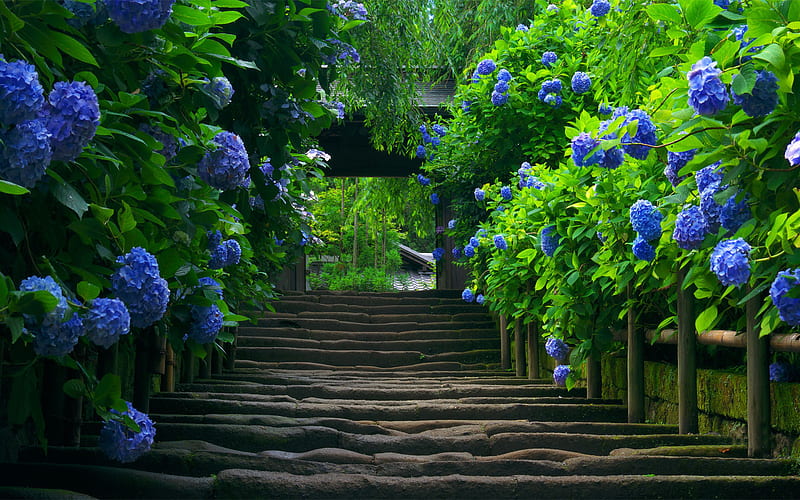Adding vibrant colors to your garden can transform an ordinary space into a spectacular outdoor retreat. Blue flowering trees, in particular, offer a unique touch of elegance and tranquility. With their serene hues, these trees can create a striking contrast against other garden elements, making them a perfect choice for adding visual interest and beauty. In this article, we’ll explore the top 10 blue flowering trees that can enhance your garden’s appeal.
1. Jacaranda
Description and Characteristics: The Jacaranda tree, known for its stunning blue-purple flowers, is a standout in any garden. This deciduous tree features fern-like leaves and produces clusters of trumpet-shaped blooms that cover the tree in late spring to early summer.
Ideal Growing Conditions: Jacarandas thrive in full sun and well-drained soil. They are suited for warmer climates and can tolerate drought once established.
Tips for Care and Maintenance: Regular watering during dry spells is essential for the Jacaranda. Pruning after flowering helps maintain its shape and promotes better growth.
2. Blue Lotus Tree (Nymphaea caerulea)
Description and Characteristics: The Blue Lotus Tree, or Blue Water Lily, is renowned for its striking blue flowers that float elegantly on the surface of ponds or water features. Its delicate petals and vibrant color make it a favorite for water gardens.
Ideal Growing Conditions: This plant prefers full sun and a location with still or slow-moving water. It requires nutrient-rich soil and regular water changes to keep the pond clean.
Tips for Care and Maintenance: Ensure that the water level remains consistent and fertilize the plant periodically. Remove any dead leaves or flowers to keep the plant healthy and blooming.
3. Blue Flax Lily (Dianella caerulea)
Description and Characteristics: The Blue Flax Lily is a compact shrub with narrow, arching leaves and striking blue-purple flowers. It blooms in late spring and summer, adding a burst of color to your garden.
Ideal Growing Conditions: This plant thrives in full sun to partial shade and well-drained soil. It is drought-tolerant and suited for various garden styles, including cottage gardens and rock gardens.
Tips for Care and Maintenance: Regular watering and occasional pruning will help keep the Blue Flax Lily in top condition. It is generally low-maintenance and adaptable to different soil types.
4. Buddleia ‘Blue Chip’
Description and Characteristics: Buddleia ‘Blue Chip,’ commonly known as the Blue Chip Butterfly Bush, produces a profusion of small, fragrant blue flowers that attract butterflies and other pollinators. Its compact size makes it suitable for smaller gardens.
Ideal Growing Conditions: This plant prefers full sun and well-drained soil. It is tolerant of drought once established and can handle various soil conditions.
Tips for Care and Maintenance: Prune the plant in early spring to encourage new growth and more blooms. Regular deadheading will also help prolong the flowering period.
5. Blue Magnolia (Magnolia x soulangeana ‘Blue Moon’)
Description and Characteristics: The Blue Magnolia, or Magnolia ‘Blue Moon,’ features large, stunning blue flowers with a delicate fragrance. Its broad, glossy leaves provide a beautiful backdrop for the blooms.
Ideal Growing Conditions: Blue Magnolias thrive in full sun to partial shade and well-drained, slightly acidic soil. They are suited for temperate climates and require regular watering.
Tips for Care and Maintenance: Apply mulch around the base to retain soil moisture and protect the roots. Prune after flowering to maintain the tree’s shape and remove any dead or damaged wood.
6. Royal Blue Crape Myrtle (Lagerstroemia indica)
Description and Characteristics: The Royal Blue Crape Myrtle is known for its stunning blue to purple flowers that appear in clusters during summer. Its attractive bark and foliage add visual interest throughout the year.
Ideal Growing Conditions: This tree thrives in full sun and well-drained soil. It is heat-tolerant and can withstand drought conditions once established.
Tips for Care and Maintenance: Regular watering during dry periods and annual pruning will help maintain its shape and encourage abundant blooming.
7. Bluebell Tree (Paulownia tomentosa)
Description and Characteristics: The Bluebell Tree, or Empress Tree, is admired for its large, tubular blue flowers that resemble bluebells. It has large, heart-shaped leaves and a fast-growing habit.
Ideal Growing Conditions: It prefers full sun and well-drained soil. This tree grows best in warm climates and can tolerate a range of soil types.
Tips for Care and Maintenance: Regular watering and occasional pruning will help the Bluebell Tree maintain its shape and health. It may require staking when young to support its rapid growth.
8. Blue Moon Wisteria (Wisteria floribunda ‘Blue Moon’)
Description and Characteristics: The Blue Moon Wisteria is a vigorous vine with cascading clusters of blue flowers that create a dramatic effect. It’s ideal for covering trellises, arbors, and pergolas.
Ideal Growing Conditions: This plant thrives in full sun to partial shade and well-drained soil. It requires a sturdy support structure to accommodate its vigorous growth.
Tips for Care and Maintenance: Prune after flowering to control growth and promote a second bloom. Regular watering and occasional fertilizing will keep the plant healthy and blooming.
9. Sky Blue Hydrangea (Hydrangea macrophylla)
Description and Characteristics: The Sky Blue Hydrangea is known for its large, round clusters of blue flowers. It adds a soft, romantic touch to any garden and is perfect for shaded areas.
Ideal Growing Conditions: It prefers partial to full shade and moist, well-drained soil. The color of the blooms can be influenced by soil pH, with more acidic soils producing bluer flowers.
Tips for Care and Maintenance: Regular watering and mulching will help maintain soil moisture. Prune in late winter or early spring to remove old blooms and encourage new growth.
10. Blue African Lilac (Halleria lucida)
Description and Characteristics: The Blue African Lilac is a small tree or shrub with clusters of tubular blue flowers that attract birds and butterflies. Its evergreen foliage provides year-round interest.
Ideal Growing Conditions: This plant thrives in full sun to partial shade and well-drained soil. It is suitable for a range of climates, including both temperate and subtropical regions.
Tips for Care and Maintenance: Regular watering and light pruning will help maintain its shape and health. It’s generally low-maintenance and adaptable to different garden conditions.
Conclusion
Incorporating blue flowering trees into your garden can create a stunning visual impact and enhance the overall aesthetic. From the elegant Jacaranda to the vibrant Blue African Lilac, each of these trees offers unique beauty and charm. By selecting the right blue flowering trees for your garden, you can enjoy a colorful and tranquil outdoor space throughout the seasons.
Explore more tips and gardening inspiration at Grandma Gardens.

